
Onychomycosis(nail fungus) is a fungal infection of the nail plate and surrounding structures: nail folds, matrix (growth part of the nail) and nail bed. It manifests itself as deformation and thickening of the nails, a change in their color: the nails become white or yellow.
This disease is quite common. The prevalence of onychomycosis in Europeans, according to some data, reaches 10-12%, exceeding the known indicators of the previous decade. It occurs 1. 5 times more often in men, but they go to the doctor 2 times less often than in women. Elderly people get sick more often, children very rarely.
The main problem in treating the disease is that patients turn to the dermatologist long after the first symptoms appear. Because of this, the pathological fungus covers a large area and treatment is delayed.
Pathogenic fungi can only be transmitted by a sick person. Very often the fungal infection occurs within the family, since the source is not identified in time and adequate preventive measures are not taken.
Causes of the disease:most often direct contact with the patient or with the objects used by him (shoes, clothes, bath mats, wipes, manicure accessories). Infections often occur when visiting gyms, baths, saunas and swimming pools.
The development of the disease is facilitated by microdamage: cracks in the interdigital folds that occur due to abrasion, excessive sweating, dry skin, poor drying after water procedures and flat feet.
Nail mycosis can also occur in the presence of concomitant diseases of the endocrine system (diabetes mellitus, obesity, hypothyroidism), vascular diseases of the extremities (venous insufficiency, lymphostasis), immune disorders, as well as with the use of antibiotics, corticosteroids and cytostatic drugs . As a result of the above diseases, blood microcirculation in the nail area is disrupted and natural immunity is reduced, which contributes to the development of secondary infections.
Onychomycosis is caused by the following types of fungi:
- dermatophyte;
- yeast-like fungi of the genus Candida;
- mold.
Depending on the type of pathogen, the penetration of the fungal infection and the clinical picture occurs differently, so therapeutic approaches also differ.
Toenails are affected by fungus 10 times more often than fingernails. In most cases, the fungus is caused by dermatophytes (e. g. Trichophyton rubrum). The remaining cases are mostly caused by non-dermatophyte molds (Aspergillus, Scopulariopsis, Fusarium).
If you notice similar symptoms, see your doctor. Do not self-medicate: it is dangerous for your health!
Along with nail fungus, foot fungus can also develop. Mycosis of the feet (dermatophytosis, Tinea pedis) is a skin disease of the feet caused by pathogenic or opportunistic fungi. Skin changes on the feet are characterized by peeling, accompanied by itching. In case of severe injuries, against the background of red and swollen skin, erosions and deep cracks appear on the soles of the feet and in the spaces between the toes, which are accompanied by pain and make walking difficult.
The advent of modern antifungal drugs has improved the epidemiological situation, but mycosis of the feet still remains one of the most significant problems in dermatovenerology. The use of some drugs is limited in the elderly and in patients with chronic diseases.
Routes of infection
The risk of contracting a fungus is especially high in public places with high humidity. These are saunas, swimming pools, gyms, public baths, etc. The most common routes of infection:
- direct contact with an infected person. Here the fungus moves from its habitat to healthy areas, thus causing an infection;
- domestic way. In this case, infection occurs when using the patient's personal belongings: shoes, personal hygiene items, etc.
Risk factors
The incidence of onychomycosis increases around the age of 60. At this time, the probability of developing such an infection is 60%, which is explained by a slowdown in metabolism, especially in the distal (remote) parts of the body, namely the fingers and toes.
Other risk factors for developing nail fungus include:
- diabetes;
- varicose veins;
- injuries to nails and adjacent tissues;
- HIV and other immunodeficiency conditions;
- long-term use of antibiotics;
- weakened immune system;
- vascular and skin diseases, dermatitis, diaper rash;
- disturbances in blood supply to the extremities;
- insufficient hygiene.
Symptoms of onychomycosis (nail fungus)
The longer the disease lasts, the more pronounced its symptoms become. The main signs of onychomycosis include:
- dyschromia: change in the color of the nail to yellow, black, green, gray or brown (the type of color depends on the type of fungus);
- onycholysis: separation of the nail plate from the bed;
- change in the thickness of the nail plate;
- hapalonychia: decrease in the thickness of the plaque and its softening;
- koilonychia: the nail appears concave, teaspoon-shaped;
- pachyonychia: thickening of the nail plate, hypertrophy of the nails;
- onychogryphosis: thickening, discoloration of the nail plate, curved in the shape of a beak;
- change in the thickness of the nail bed (hyperkeratosis - thickening of the nail bed);
- changes in the surface of the nail plate: pits, grooves, ridges;
- changes in the nail folds and surrounding skin (paronychia - inflammation of the proximal nail fold).
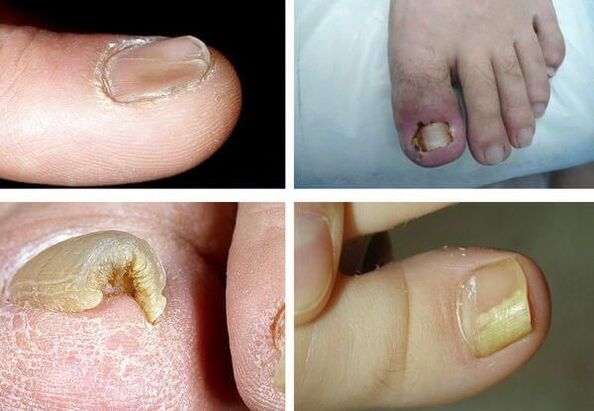
It is important to note that none of the symptoms are pathognomonic, that is, suitable exclusively for a specific pathogen, therefore it is impossible to determine it based on symptoms - further examinations are required.
Pathogenesis of onychomycosis (nail fungus)
The pathogenesis of the disease depends on how the fungus got on the skin and nails.
Distal subungual type:if the fungus has penetrated the skin in the area of the nail folds or in the distal area, the infection spreads through the free edge of the nail into the bed and further to the matrix. Initially, the nail plate may not change, but later, due to hyperkeratosis, it gradually moves away from the nail bed and becomes yellowish. The nail plate may gradually thicken.
White Surface Type:If whitish lesions form on the surface of the nail, over time the fungus takes over the entire nail plate. The nail thickens, crumbles and acquires a gray-brown tint. In this case, the matrix and epithelium of the nail bed are not affected. There is no inflammation of the surrounding skin.
Proximal subungual type:the fungus can spread from the skin and periungual folds to the nail plate and subsequently to the matrix, reaching the distal parts of the nail plate. Spots appear on the nail in the area of the hole and the nail bed, and detachment of the nail plate occurs. There is no significant inflammation of the nail bed or matrix.
Total dystrophic type:The entire nail is affected. The proximal portions of the nail fold disappear or thicken so that the nail plate can no longer form or grow.
Existsbiophysical concept of the pathogenesis of onychomycosis, which states that during the disease there is a confrontation between two forces: the growth of the fungal colony towards the matrix, and the natural growth of the nail from the matrix to the distal edge. Therefore, the speed of growth of the nail is crucial in the course of onychomycosis: the faster the nail grows, the sooner healing will occur. Perhaps this is what explains the low prevalence of the disease in children, since their nails grow faster than those of adults and the elderly.
Classification and stages of development of onychomycosis (nail fungus)
There is the following classification of onchomycosis:
- distal subungual;
- superficial white;
- proximal subungual;
- total dystrophic.
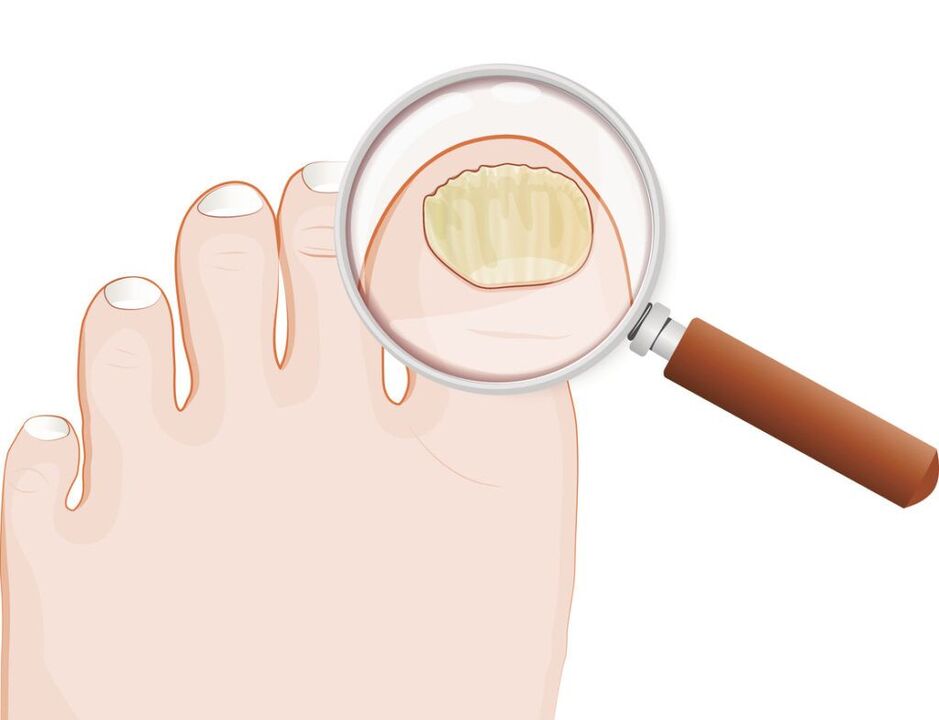
According to the classification of Arievich (1970):
- normotrophic: in the thickness of the nail there are yellowish and whitish stripes, but the shape of the nail plate does not change, there is no subungual hyperkeratosis;
- hypertrophic:the nail plate turns yellow, thickens due to subungual hyperkeratosis, becomes brittle, with jagged edges;
- dystrophic:The thinning and detachment of the nail plate from the nail bed occurs with the formation of voids.
Complications of onychomycosis (nail fungus)
Long-term onychomycosis increases the risk of developingdiabetic foot(formation of trophic ulcers on the legs) egangreneif the patient has diabetes mellitus or vascular disease of the lower extremities.
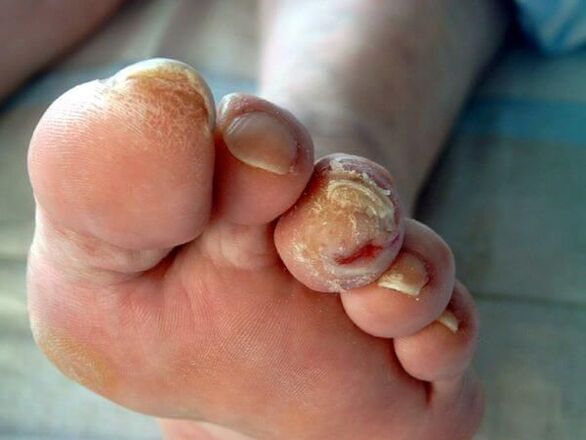
In immunosuppressive conditions (primary and secondary immunodeficiencies), fungi can spread to the skin, internal organs and cause allergies in the body. This can manifest as skin rashes and even in the development of bronchial asthma.
In a simple course, the disease causes traditional symptoms of the fungus, causing only serious discomfort in a person. But without treatment, onychomycosis can cause complications. Most often they manifest themselves with the addition of a bacterial infection.
Sometimes onychomycosis is very acute with the appearance of blisters, ulcerations and exuding areas on the skin near the nail. In more severe cases, the disease takes on a generalized form. This means that the nail fungus spreads to the internal organs and systems and therefore the patient will require emergency hospitalization.
Diagnosis of onychomycosis (nail fungus)
Before looking at the methods of diagnosing onychomycosis, it is necessary to explain how to correctly collect material for research (the patient does this independently or prepares his nails before diagnosis). Before collecting material for research, it is necessary to treat the nail plate with 70% alcohol to avoid contamination with other bacteria.
The method of collecting the material varies depending on the form of onychomycosis:
- superficial shape- carry out a scraping from the nail plate;
- distal form- both a scraping of the nail bed and a piece of nail plate are needed;
- proximal subungual form- the material is taken with a drill, or a biopsy of the nail is performed, or a scraping of the nail bed is performed.
The fastest method for determining pathological fungi in the nail ismicroscopy. Technique: the material under study is treated with an alkaline solution to dissolve the keratin. To make the mushroom threads better visible, ink is added to the alkali. Subsequently, the resulting preparation is studied under a microscope.
This search method is the fastest and most objective. Sensitivity is up to 80%. The disadvantages of the method include the fact that when using it it is impossible to determine the type of pathogen.
Bacteriological culture: It is an additional method for diagnosing onychomycosis. The material is sown on a special medium and the result is interpreted under the microscope after 2-3 weeks. This method allows you to determine the type of pathogen: this helps determine treatment tactics and select drugs based on sensitivity. But the disadvantage of the study is that it takes a long time and its sensitivity is only 30-50%.
Biopsy: Using a scalpel and applying anesthesia, the nail and nail bed are cut. The material is immersed in a formaldehyde solution and sent for histological examination to the laboratory. The advantages of this method are that it is highly sensitive and allows you to determine the presence of a pathological fungus in the material.
Disadvantages: it is impossible to identify the pathogen, as well as establish the viability of microorganisms, the method is expensive and labor-intensive.
Genetic diagnostics: molecular biological research method (PCR). This is one of the new and highly sensitive methods of diagnosing onychomycosis: it helps to detect the DNA of the causative agent of the disease. In our country it is recommended to introduce this type of diagnostics in those medical institutions that have PCR laboratories, but at the moment it is planned to introduce test systems for the identification of dermatophytes and molds only in laboratories. The method allows you to determine the type of pathogen, and its sensitivity varies from 80 to 90%. Disadvantages: high costs, inaccessibility, lack of technological standards and implementation complexity.
Doctors are increasingly introducing themselves into practicedermoscopy. Using this method, you can evaluate changes in the color and structure of the nail, as well as the condition of the surrounding structures. The dermatoscopic examination allows a more accurate assessment of the depth of damage to the nail plate and a more correct calculation of the onychomycosis severity index (KIOTOS).
First of all, the patient is sent for microscopy, which allows you to identify the presence of the pathogen. In the future, it will be necessary to determine the type to select the correct treatment for toenail fungus. At the JSC "Medicine" (academic Roitberg's clinic) in the center of Moscow, the most modern and widespread methods of diagnosing onychomycosis are practiced:
- cultural examination of a biological sample of affected tissue. To do this, it is placed in an artificial nutrient medium, where the pathogen is grown to determine its type;
- Polymerase chain reaction (PCR) method of detecting pathogen DNA in a sample of affected tissue.
When to see a doctor
Many who have encountered onychomycosis know that the disease develops slowly and is incredibly difficult to treat. That is why it is very important to consult a doctor when the first signs of the disease appear. A dermatologist treats onychomycosis of the nails in our clinic in the center of Moscow. The specialist will provide competent assistance and guide you until complete recovery.
Preparing for the visit to the doctor
Before visiting a dermatologist, it is important not to treat the affected areas of the nails with anything, e. g. do not use drugs, including iodine and brilliant green. It is also necessary to avoid the use of creams and ointments against fungi. At the appointment you should take all previously carried out tests, including those for other diseases. The affected nails should not be cut for 3-4 days before the consultation.
Treatment of onychomycosis (nail fungus)
There are several types of treatment for onychomycosis:
- Local therapy.
- Systemic therapy.
- Combined therapy.
- Corrective therapy.
Local therapyinvolves applying medications to the nail plate and nail folds. Indications for local therapy:
- Limited form of damage to the nail plate (according to KIOTOS).
- There are contraindications to the prescription of systemic drugs: hypersensitivity, liver disease, renal dysfunction, pregnancy, breastfeeding.
The advantages of this therapy are that high concentrations of the therapeutic agent are formed on the surface of the nail, which does not penetrate into the bloodstream. There are no side effects in the use of antifungal drugs: nausea, loss of appetite, abdominal pain. The disadvantage of this method is that the medicinal substance does not always reach the habitat of the pathogen, especially if the fungi are located in the nail bed or matrix. This in turn can lead to treatment failure. This type of treatment is labor-intensive, since before applying the medicine it is necessary to remove the affected part of the nail.
Methods for removing affected nails:
- Mechanical removal using files, cutters or drill.
- Use of keratolytic patches. Before applying keratolytic plaster, the skin around the nail is sealed with a plaster, a plaster mass (urea with salicylic acid) is applied on top and sealed with an adhesive plaster. The plaster mass is changed every 2-3 days. After each removal, the affected part of the nail is removed mechanically.
- Surgical. This operation is very painful and traumatic, since when the nail plate is removed, the growth zone can be damaged, which leads to the regrowth of deformed nails.
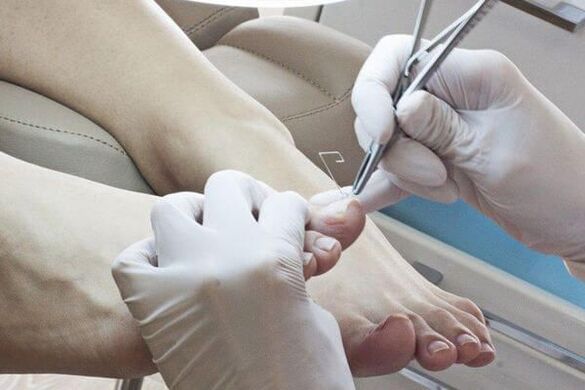
Local antifungal agents are used after removing the affected nail plate.Antifungalsdistinguished by place of application:
- applied to the nail: varnishes;
- applied to the rollers: creams, ointments, solutions.
The most studied topical drug is1% naftifine solution., which has an evidence base for the effectiveness of the treatment based on a Cochrane meta-analysis. This product is water-based, which facilitates better penetration of the antifungal substance into the affected area. Paints, the active ingredients of which are ciclopirox and amorolfine, have a dehydrated base, which reduces the penetration of the drug into the deep layers. Therefore dermatologists consider the use of paints unsatisfactory and increasingly prefer water-based products.
To obtain results from local therapy it is necessary to follow the therapeutic regimen; it is important that the patient is responsible, consistent and patient. The duration of therapy can be up to 12 months.
Systemic therapyallows the antifungal drug to penetrate the bloodstream to the lesion site, even if the nail bed and matrix are affected. A high concentration of the drug remains in the affected area for a long time after the end of use. The disadvantages of this type of treatment are associated with the risk of side effects and toxic effects.
Indications for systemic therapy:
- Common forms of damage to the nail plate.
- Lack of effect of local therapy (i. e. after six months of treatment for onychomycosis of the hands and 9-12 months of treatment for onychomycosis of the feet, healthy nails did not grow back).
To determine the therapeutic tactics, KIOTOS (Clinical Index for assessing the severity of Sergeev's onychomycosis), proposed by A. Yu Sergeev in 1999, is used. It is used as a therapeutic standard in various countries of the world.
Medicinesfor the treatment of onychomycosis can be classified as follows:
- antifungals: have an antifungal effect;
- antiseptics: have both antifungal and antibacterial effects. They are rarely used, only if no other antifungal agents are present;
- multicomponent: in addition to the antifungal agent, they also contain other drugs, such as anti-inflammatory drugs.
Prescription regimens:
- standard: taking medications every day during the prescribed treatment period;
- shortened: the treatment period is shortened, it can be carried out at regular doses or increased;
- intermittent: treatment is prescribed in several short courses, the intervals between courses are equal to the duration of the courses;
- pulse therapy: treatment is prescribed in several short courses, the intervals between courses are longer than the duration of the courses.
Antifungal drugs are divided according to the active ingredient:
- triazoles;
- allylamines;
- others (third generation drugs).
Currently used for systemic therapyonly third generation drugs.
With combined therapylocal and systemic treatment are carried out simultaneously. Combination therapy is used when it is necessary to increase the effectiveness of systemic therapy and reduce treatment time.
Corrective therapy(treatment of concomitant diseases): to select a therapeutic regimen, it is necessary to evaluate the general somatic condition of the body. Diseases such as circulatory disorders in the extremities can reduce the access of the antifungal agent to the lesion. Therefore, drugs that improve tissue trophism are prescribed.
Due to the toxic effect of systemic antifungal drugs, it is necessary to exclude liver disease and, if necessary, prescribe hepatoprotectors.
Home remedies
Before using home remedies, you should consult your doctor. With his permission, you can use the following recipes:
- iodine. Before use, the feet should be steamed, washed with laundry soap, and then the affected areas of the nails should be removed. After that, treat the nails and skin between the fingers with iodine, soak them in a bath with a soda solution for 20-30 minutes and dry them thoroughly;
- vinegar. For 3 liters of water take 1 tbsp. apple cider vinegar and add a little potassium permanganate. Soak your feet in the bathtub for 20-30 minutes, then dry them thoroughly;
- hydrogen peroxide. After thoroughly steaming your feet, remove the affected areas from the nails. Place cotton pads soaked in hydrogen peroxide on top, wrap them with a bandage and leave them to act for half an hour.
Dangerous myths and misconceptions in the treatment of nail fungus
One of the most important and dangerous myths is that nail fungus is not considered a serious disease. In fact, onychomycosis, as it progresses, can lead to serious consequences, including deformation and complete rejection of the nails from the nail bed.
Furthermore, an infected person represents a daily danger for their loved ones, since being close to them they also risk falling ill. That's why it's important to know how to cure nail fungus on time.
Forecast. Prevention
The sooner a patient consults a doctor with signs of fungal nail infection, the faster the disease can be cured and the nail plate restored. With long-term processes involving the entire nail, the treatment of onychomycosis can be long, but if all recommendations are followed, healing often occurs. If there are contraindications to systemic therapy, long-term maintenance treatment with local drugs is necessary.
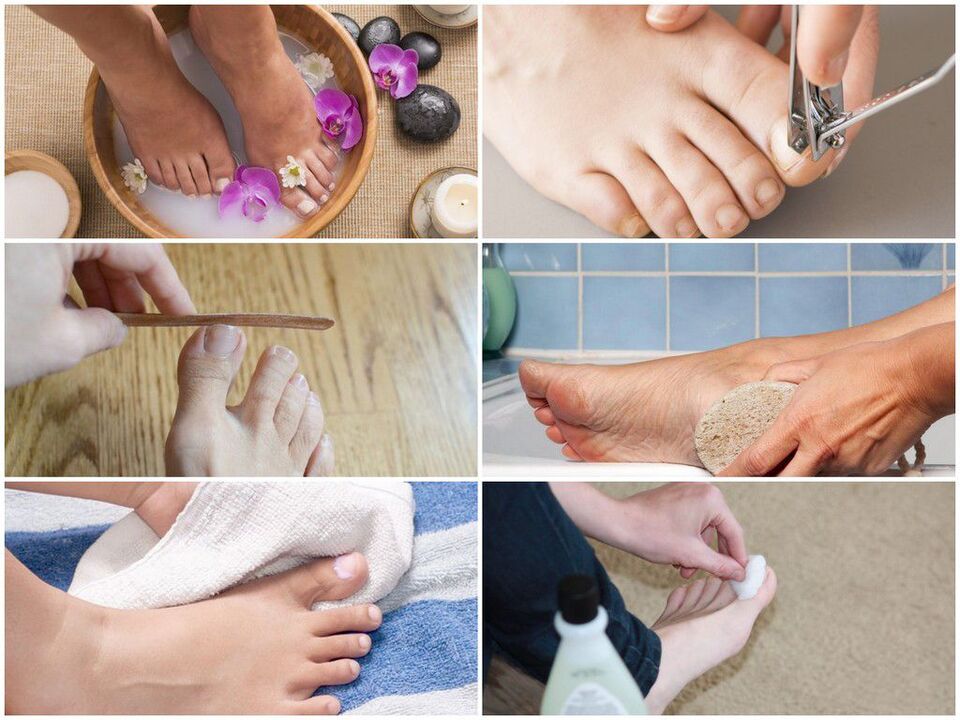
For preventionIt is necessary to observe the rules of personal hygiene and reduce the possibility of reinfection:
- try to wear comfortable, quality shoes (to avoid excessive sweating of the feet);
- It is advisable to change socks and tights daily;
- use only individual shoes. For those being treated for onychomycosis, shoes must be treated at the beginning of treatment, at least once a month throughout the treatment period and after its completion;
- if necessary, use antiperspirants for the feet;
- use an individual nail care kit (scissors, files);
- before and after visiting public places (swimming pool, bathhouse, gym) use external antifungal agents (sprays, creams and pencils);
- identify the source of the fungal infection in the family and be treated at the same time.
It is recommended to periodically carry out antifungal treatment of personal items, shoes, bathtubs, floors and carpets. For these purposes you can use a 40% acetic acid solution, 1% chlorhexidine alcohol solution (prescribed by a doctor) and disinfectant solutions. Linen can be boiled in a 1-2% soap-soda solution for 20-30 minutes, ironed at the highest temperature.
























